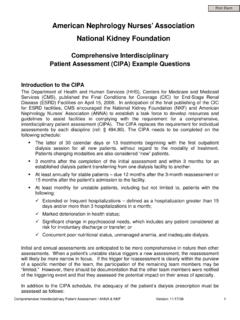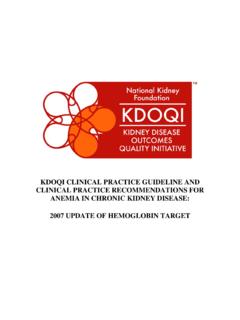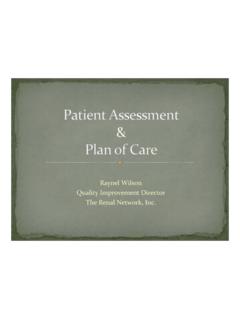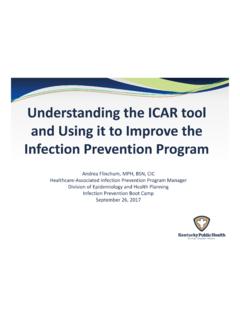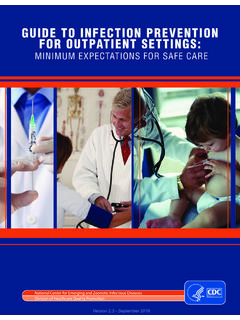Transcription of Clinical Performance Goals - The Renal Network
1 Clinical Performance Goals 2010-2011 Page 1 Clinical Performance Goals 2010-2011 Table of Contents _____ Table of Contents .. 1 Health Care Quality Improvement Program .. 2 Clinical Performance Measures .. 6 Chapter 1: hemodialysis CPM Indicators .. 7 Adequacy of Dialysis .. 8 Anemia Management .. 11 Nutritional Status .. 14 Bone and Mineral Metabolism .. 15 Vascular Access .. 17 Chapter 2: Peritoneal Dialysis CPM Indicators .. 19 Adequacy of Dialysis .. 20 Anemia Management .. 21 Nutritional Status .. 24 Bone and Mineral Metabolism .. 25 Chapter 3: Other QAPI Initiatives .. 27 Medical Injuries and Medical Errors Identification .. 28 Hemodialyzer Reuse Program .. 30 Patient Satisfaction and Grievances .. 31 Health Outcomes: Physical and Mental Functioning and Patient Survival.
2 32 Infection Control .. 33 5-Diamond Patient Safety Program .. 35 Additional Information .. 37 Page 2 Health Care Quality Improvement Program _____ The Centers for Medicare & Medicaid Services (CMS), which oversees the Medicare program, contracts with 18 ESRD Network Organizations throughout the United States. The ESRD Networks perform oversight activities to assure appropriateness of services and protection for ESRD patients. This approach has been named the ESRD Health Care Quality Improvement Program (HCQIP). The ESRD HCQIP is based on the assumption that most health care providers need and welcome both information, and where necessary, help in applying the tools and techniques of quality management. The Network has established Performance Goals based on past Performance , CMS thresholds and the NKF-K/DOQI Clinical Practice Guidelines.
3 With the new Conditions for Coverage, the expectation is that facilities develop an internal Quality Assessment and Performance (QAPI) plan to promote continuous improvement. Page 3 Health Care Quality Improvement Program _____ Excerpt from the Conditions for Coverage The dialysis facility must develop, implement, maintain, and evaluate an effective, data-driven, quality assessment and Performance improvement (QAPI) program with participation by the professional members of the interdisciplinary team. The program must reflect the complexity of the dialysis facility s organization and services (including those services provided under arrangement), and must focus on indicators related to improved health outcomes and the prevention and reduction of medical errors.
4 The dialysis facility must maintain and demonstrate evidence of its quality improvement and Performance improvement program for review by CMS. The Measures Assessment Tool (MAT) is a reference for community-accepted standards and values for listed elements of QAPI required in the Conditions for Coverage. Facilities are expected to use the community-accepted standards and values associated with Clinical outcomes as referenced on the MAT. Facilities are also expected to use the fourth-quarter Lab Data , CROWNWeb (when it becomes available), and Dialysis Facility Reports to determine comparison or average values associated with Clinical outcomes. Page 4 Health Care Quality Improvement Program _____ You can access the latest MAT by going to the Network websites: click the Conditions for Coverage link -- click the Conditions (CfC) link This Clinical Performance Goals document provides measures (based on the MAT requirements) to assess facility-level patient care processes and outcomes, and to identify opportunities for improvement.
5 The goal of the Network is to combine efforts with Renal facilities to improve Performance in the delivery of quality patient care. Page 5 Format of this Booklet _____ hemodialysis and Peritoneal Dialysis Clinical indicator Goals differ slightly. This booklet groups the major domains of care by modality. Look for the Blue or Green flag in the upper right corner of the page, which are used to differentiate between the modalities. Chapter 1 deals with hemodialysis Clinical indicators and has a blue flag. Chapter 2 deals with Peritoneal Dialysis Clinical indicators and has a green flag. Chapter 3 includes additional QAPI topics that are mentioned by the Conditions for Coverage. All data represented in the tables and graphs come from the fourth-quarter Lab Data 2009 aggregate, unless otherwise specified.
6 These results are inclusive of all insurance types ( Medicare beneficiaries and non-Medicare individuals) and are not limited by prescription, Anemia results are for all patients not just those receiving ESA. HD PD Page 6 Clinical Performance Measures _____ The ESRD Clinical Performance Measures (CPM) Project is a national effort led by CMS and the 18 ESRD Networks. For 16 years, Clinical information was collected and reported with unit, state, Network and national comparisons. As the ESRD program transitions to an all electronic collection method, the data used to drive this effort was in the form of the fourth-quarter Lab Data project (aggregated for the time period of October-November-December) and Vascular Access projects (aggregated monthly).
7 Facilities are asked to report Clinical information designed to reflect values for the five major domains of care: Adequacy of Dialysis, Anemia Management, Nutritional Status, Bone and Mineral Metabolism and Vascular Access. Page 7 Chapter 1: hemodialysis CPM Indicators _____ Topics included in this section: Adequacy of Dialysis including Kt/V and URR Anemia Management Nutritional Status Bone & Mineral Metabolism Vascular Access Page 8 Adequacy of Dialysis _____ Numerous outcome studies have demonstrated a correlation between the delivered dose of hemodialysis and patient mortality and morbidity. The intent of QAPI in addressing adequacy of dialysis is to maximize the number of patients who achieve the Goals for adequate dialysis, which includes both successful fluid volume management and clearance of toxins.
8 Urea Reduction Ratio (URR) Pre- and post-dialysis blood urea nitrogen (BUN) levels were drawn and reported to calculate URR results. The Renal Network has a goal to maintain the URR rate of 96% of patients with a URR 65%. The results provided by the 2009 Lab Data Collection project show that each of our three Networks are above the national mean with compliance to this measure; however, we are below our target. Network Outcomes and Process Goals Each patient should be measured for adequacy every month. 96% of unit s hemodialysis patient population (3x/week) achieve URR 65 .. OR .. 96% of unit s hemodialysis patient population (3x/week) achieve Kt/V Daugirdas II HD Page 9 Adequacy of Dialysis _____ URR Data PA DE NW4 IN KY OH NW9 IL NW10 Our Goal Mean URR 73 74 73 74 73 73 73 73 65 % Patients with mean URR 65 Compliance to the URR 4 Net 9 Net Goal HD Page 10 Adequacy of Dialysis _____ Kt/V Kt/V was reported for all patients in the Lab Data Collection project.
9 The Renal Network has a goal to maintain 96% of patients with a Kt/V , calculated using the Daugirdas II method for hemodialysis patients. The 2009 Lab Data Collection results show each of our Network areas are close to our target compliance rate. Kt/V Data PA DE NW4 IN KY OH NW9 IL NW10 Our Goal Mean Kt/V % Patients with mean Kt/V Compliance to the Kt/V 4 Net 9 Net Goal HD Page 11 Anemia Management _____ A normocytic, normochromic anemia is present in the majority of Chronic Kidney Disease (CKD) patients. Untreated CKD associated anemia can result in a number of physiologic abnormalities that can reduce the quality of life and decrease patient survival. The intent of QAPI in addressing management of anemia is to maximize the number of patients who achieve the Goals for this area.
10 Network Outcomes and Process Goals Reviewing a three-month average of the last hemoglobin result of the month < 25% of patient population with average hemoglobin > 12 g/dL < 5% of patient population with average hemoglobin < 10 g/dL Maximize the percent of patients within 10-12 g/dL while minimizing the percent of patients above 12 g/dL and below 10 g/dL. Periodic adjustment of the facility anemia management protocol will help to realize these Goals over many months. Determine expected hemoglobin rates based on facility size and population mean hemoglobin of g/dL using a statistical technique and actual Network hemoglobin data. This analysis provides a report of what we should realistically expect to see each month in the three hemoglobin ranges.

